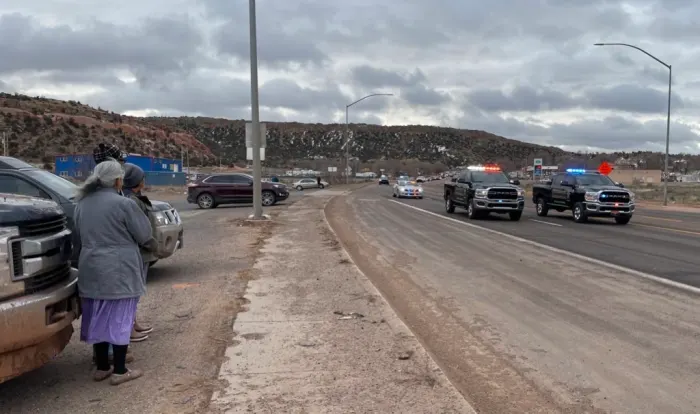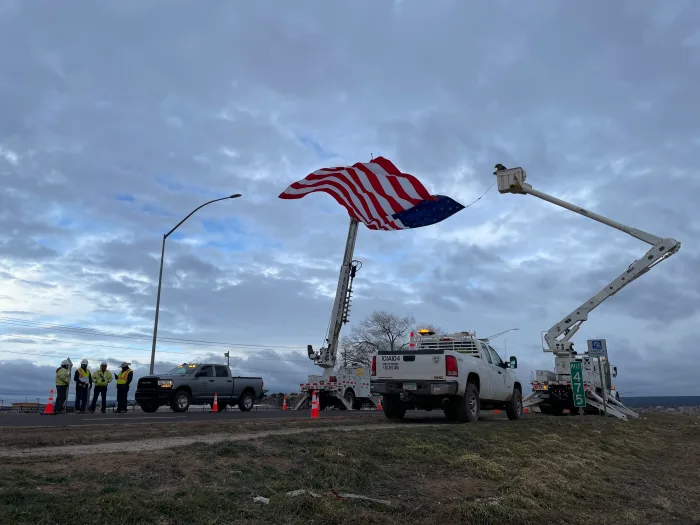The billboard project is expanding to Oregon
<br>Peterson Zah’s final journey through Navajo
Jourdan Bennett-Begaye and Noel Lyn Smith
ICT

Irving Obtoe Cayedito, 78, from St. Micheals, Arizona pays his respects for late and former Navajo Nation President Peterson Zah during the procession Saturday morning in Window Rock. Zah died March 7, 2023. (Photo by Sharon Chischilly for Source N.M.)
The historic tribal and education leader was laid to rest Saturday following a 100-mile procession through the reservation
It was a quiet, cloudy and cold morning in Tsé Bonito, New Mexico. There were six people standing alongside Highway 264 that leads into Arizona.
There were breakfast burrito sellers parked on the side of the road, $5 each. Otherwise, the highway was quiet and sparsely populated. One man removed his winter cap when the SUV hearse from Silver Creek Mortuary approached.
Traffic came to a stop on the normally busy highway as the Navajo Police Department led the procession of approximately 50 vehicles that would travel about 100 miles, taking former Navajo Nation president Peterson Zah, one of the most revered politicians on the Navajo Nation, to his resting location in Low Mountain, Arizona.

Zah, 85, died on March 7 at home in Window Rock, Arizona, according to his family.
The funeral procession started in Tsé Bonito before continuing nearly 100 miles to Low Mountain Arizona, where Zah was buried in a private service.
The procession would be Zah’s last ride through the Navajoland that he worked so hard for. It was also a chance for people to pay respect.
To Theresa Kedelty, former Zah was “a kind, passionate man” who did not hesitate to help tribal members.
Kedelty was among a small group of people standing next to the Highway near the New Mexico and Arizona state line.
Wearing a winter jacket and a purple three-tier skirt, Kedelty, of Crystal, New Mexico, wiped tears from her face as the motorcade passed.
She said that she knew Zah since he was executive director of DNA-People’s Legal Services. There he helped her parents with a legal matter several decades ago.
Her other memory of Zah happened when winter weather prevented her parents from picking up her, her brother and a friend in Gallup, New Mexico, a border town in the southeast region of the reservation.
She explained that her brother walked to the city’s downtown area, where he ran into Zah and told him about their situation.
“He (Zah) didn’t hesitate. We piled into his International truck and he took us all the way back to Crystal,” she said.
The International Truck refers to the beat up pickup truck that Zah drove during his presidency. It became an icon, the symbol and reminder that Zah chose to drive himself instead of using a presidential motorcade. Since those encounters, Kedelty watched Zah’s leadership and political career flourish over the years.
Zah has the distinction of serving as the last chairman of the Navajo Tribal Council and being elected the first tribal president in 1990.
He continued to be a voice in leadership and advocacy on and away from the Navajo Nation after completing his presidential term in 1995.
“I think he was one of the great Navajo statesmen. I don’t think we’ve had anyone like him since he left the presidency,” Kedelty said.
The last time she saw Zah was in summer 2022 at a campaign rally in Round Rock, Arizona, where she greeted and spoke with the former president.
Employees from the Navajo Tribal Utility Authority Fort Defiance District flew a large United States flag over Highway 264 in Window Rock.

A second display was set up by the NTUA Chinle District at the junction of Arizona Highway 191 and Navajo Route 4, south of Chinle, Arizona.
The procession drove west, through the town of Ganado, Arizona, where the weather warmed to 47 degrees, but still chilly with 15 mph winds.
A small group of vehicles gathered around the highway. There was one brown truck parked just before the pedestrian bridge that towers over the highway at the entrance of the small town.
Around 8:30 a.m. the individual in the brown truck stood outside the truck holding a large Navajo Nation flag. It whipped in the air has the person yelled to the others beyond the bridge, “They’re at the Kinlichee turnoff!” They had to yell it a few times for the others to understand it.
A blue truck parked next to the bridge. An older gentleman held a small white flag with the Navajo Nation seal. A woman stood next to him.
The motorcade could be heard over the hill entering Ganado before it was seen, and then the Navajo Nation Police lights shined.
Waiting in the cold in Ganado. Folks have their Navajo Nation flags up. pic.twitter.com/A10yKauZdY
— Jourdan Bennett-Begaye (@jourdanbb) March 11, 2023
More vehicles had shown up. A total of 15 vehicles and maybe 25 people. Some sat inside to keep warm and others braving the cold.
The line passed under the pedestrian bridge at 8:40 a.m.
Navajo people and Navajo Nation residents, a few with hands over their hearts, watched as the police sirens rang through the air waking up Ganado.
The motorcade procession continued through Burnside with police stopping traffic at the roundabout to head 24.3 miles north on U.S. Highway 191 toward Chinle.
Cars and trucks headed southbound pulled over in the long stretch of road out of respect. With little-to-no cell signal, the Navajo Nation’s radio station, KTNN, was pretty much the only station accessible at this point.
Puffy Arizona clouds hung above the procession line surrounded by dark clouds in the distant, and mesas and canyons colored in dark pink, and miles of red and brown dirt.
It was as if Diné Bikéyah, Navajoland, wanted to show Dr. Peterson Zah a memorable send off.
A group of 20 cars gathered at the junction of Highway 191 and Navajo Route 4. The Navajo Tribal Utility Authority Chinle District flew a flag above the highway. Similar to the one back in Window Rock.
About 20 cars parked and people at the junction of Highway 191 and Navajo Route 4. Procession turns west toward Piñon. pic.twitter.com/C51Jf22N6H
— Jourdan Bennett-Begaye (@jourdanbb) March 11, 2023
For the next 27 miles before the next turn, more folks showed their support.
In front of a snowy mesa in Cottonwood, a firetruck displayed a huge sign that read: “Thank you Dr. Zah for your strength, courage, and dedication. Rest in peace.” Both the Navajo Nation and American flags flew next to it.
There were eight people by a faded yellow cattle guard holding onto a U.S. flag that could cover half a volleyball court. The wind ripping through it. A little girl bundled up waved two smaller U.S. flags next to them.
The last 10 miles were perhaps the most symbolic of the journey. “He built this highway himself,” his niece Brenda White said. The road stretches from Whippoorwill to Low Mountain, Zah is credited for getting it paved for his community.
Community members stood on the side of that paved road near their hogans or at the entrances of the intersecting dirt roads that meet the pavement watching police cars and vehicles pass by, making their way either to the Low Mountain Senior Center or family cemetery that is nestled at the bottom of the mesa.
While the family and close friends attended the funeral and burial, the public gathered at the senior center to help with the first of two receptions that day.
Gertrude Multine was pulling apart fresh yeast rolls in the kitchen for the mini reception organized for locals and those who weren’t going to drive an hour-and-a-half back to Fort Defiance, Arizona for the larger reception. The first woman to be election speaker of the Navajo Nation Council, Council Delegate Crystalyne Curley, attended the 100-person reception in Low Mountain.
Multine said Zah was her grandfather by clan. She said he often visited the senior center after its 2004 opening to talk with other elders and eat.
“He advocated for houses for some of the elderly that didn’t have houses,” said Charlene Begay, senior center supervisor.
Back to preparing the to-go plates of a Navajo buffet: posole, blue corn mush, goulash, potato salad, pumpkin pie, fruit salad, salad, corn, vegetables, soda, and frybread.
Zah’s younger cousin-sister, Katie Ben, was also helping prepare the food. Something she said she has done for him for years.
She supported and followed him during his campaign and while in office.
“I stuck through those 16 years,” she said. She said she had to attend every meeting because she had to make the food.
She stopped to reflect on her childhood memories with him.
Ben, Zah and eight other cousins grew up together. He taught all of them how to drive. “It was a lot of fun,” she said. “Being with him herding sheep and everything else.”
They had to fill up the barrels of water every three days. “We had to put so many barrels on the wagon, take off, and get all those water barrels, and bring them back,” the 81-year-old said. They’d drop the barrels off at their houses and auntie’s houses.
She saw him for the last time about a year ago. He didn’t say he was sick, she said. He stopped by to tell her, “You helped me out a lot.” Ben teared up. “And I was thinking about it this morning.”
Zah even encouraged them to go to school beyond their days at Phoenix Indian Boarding School. And if anyone knew Zah, he was big on education and leadership.
He inspired his 61-year-old niece, Brenda White, to step into her chapter house leadership and serve her community. She was blown away by the support for her uncle.
“What I’ve been reading on the web, from what people have been posting, it’s very emotional, very emotional, and what my uncle stood for, of all the stuff that he did during the term. Even after the term,” she said.
She will never forget her experience living with him and her aunt for a year “way back in the 70s” in Window Rock. It was winter. She had missed the bus to her high school. Zah told his niece he could take her to school — in his infamous international truck.
“So we’re like, Oh, my God. You know, I was kind of embarrassed. But now I know why. He’s so proud of it,” she said. “As we were getting close to the high school I was like, ‘Oh my gosh, don’t let him don’t let him drop us off right in front. He sure did. He dropped us off right in the front.”
She remembered that he would take off with his arms extended out and he drove away.
“Now I know why you love that truck,” she said, talking to that memory of Zah.
External
Identification not yet made
UTTC International Powwow attendees share their rules for a fun and considerate event
Radio collaboration highlights importance of cooperation in a season of funding cuts for local media
A memorial in the Snow County Prison, now the United Tribes Technical College campus
Standing Rock Sioux Tribal Chairwoman Janet Alkire tells crowd, ‘We’re going to rely on each other’






